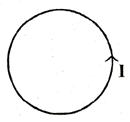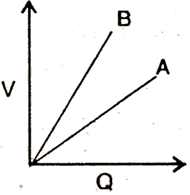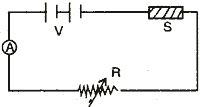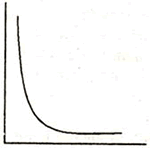- English
- Sociology
- Functional English
- Psychology
- Mathematics
- Philosopy
- Physics
- Computer Science
- Chemistry
- Entrepreneurship
- Biology
- Informatics Practices
- Geography
- Multimedia & Web Technology
- Economics
- Biotechnology
- Business Studies
- Physical Education
- Accountancy
- Fine Arts
- Political Science
- History
- Agriculture
CBSE Guess > Papers > Question Papers > Class XII > 2004 > Physics > Delhi Set-I
PHYSICS (Set I—Delhi)
Q. 1. In the diagram below is shown a circular loop carrying crurent I. Show the direction of the magnetic field with the help of lines of force. 1

Q. 2. Name the type of modulation scheme preferred for digital communication 1
Q. 3. Write the nuclear decay process for of
 1
1
Q. 4. What i the name given to that part of electromagnetic spectrum which is used for taking photographs of earth under foggy conditions from great heights? 1
Q. 5. ‘Heavy water is often used as a moderator in thermal nuclear reactors.’ Give reason. 1
Q. 6. The graph shows the variation of voltage, ‘V’ across the plates of two capacitors A and B versus increase of charge, ‘Q’ stored on them. Which of the two capacitors has higher capacitance? Give reason for your answer. 2

Q. 7. Explain with the help of diagram the terms (i) magnetic declination and (ii) angle of dip at a given place. 2
Q. 8. Two circular coils, one of radius r and the other of radius R are placed coaxially with their centres coinciding. For R >> r, obtain an expression for the mutual inductance of the arrangement. 2
Q. 9. Find the wavelength of electromagnetic waves of frequency 5 x 1019Hz in free space. Give its two applications. 2
Q. 10. Draw the graph showing the variation of binding energy per nucleon with mass number. Give the reason for the decrease of binding energy per nucleon for nuclei with high mass numbers. 2
Q. 11. With the help of a diagram, show the biasing of a light emitting diode (LED). Give its two advantages over conventional incandescent lamps. 2
Q. 12. A compound microscope with an objective of 1.0 cm focal length and an eye-piece of 2.0 cm focal length has a tube length of 20 cm. Calculate the magnifying power of the microscope, if the final image is formed at the near point of the eye. 2
Or
The magnifying power of an astronomical telescope in the normal adjustment position is 100. The distance between the objective and the eye-piece is 101 cm. Calculate the focal lengths of the objective and of the eye-piece.
Q. 13. State Gauss’ theorem in electrostatics. Using this theorem, derive the expres-sion for the electric field intensity at any point outside a uniformly charged thin spherical shell. 3
Q. 14. Find the total energy stored in the capacitors in the given network. 3

Q. 15. The diagram shows a piece of pure semiconductor, Sin series with a variable resistor R, and a source of constant voltage V. Would you increase or decrease the value of R to keep the reading of ammeter (A) constant, when semiconductor S is heated ? Give reason. 3

Q. 16. State two conditions to obtain sustained interference of light
In Young’s double slit experiment, using light of wavelength 400 nm, in terference fringes of width ‘X’ are obtained. The wavelength of light is increased to 600 nm and the separation between the slits is halved. If one wants the observed fringe width on the screen to be the same in the two cases, find the ratio of the distance between the screen and the plane of the interfering sources in the two arrangements. 3
Q. 17. Give the mass number and atomic number of elements on the right-hand side of the decay process. 2 The graph shows how the activity of a sample of radon.220 changes with time. Use the graph to determine its half-life. Calculate the value of decay constant of radon-220. 3

Q. 18. A circular coil of N turns and radius R, is kept normal to a magnetic field, given by
![]() . Deduce an expression for e.m.f. induced in this coil. State the rule which helps to detect the direction of induced current. 3
. Deduce an expression for e.m.f. induced in this coil. State the rule which helps to detect the direction of induced current. 3
Q. 19. In a series R - C ciruit,
 radian second Find the current in the circuit and calculate the voltage across the resistor and the capacitor.
radian second Find the current in the circuit and calculate the voltage across the resistor and the capacitor.
Is the algebraic sum of these voltages more than the source voltage? If yes, resolve the paradox. 3
Q. 20. Define the term ‘work function’ of a metal. The threshold frequency of a metal is f0. When the light of frequency 2f0 is incident on the metal plate, the maximum velocity of electrons emitted is v1. When the frequency of the incident radiation is increased to 5f0, the maximum velocity of electrons emitted is v2. Find the ratio of v1 to v2.3
Q. 21. Draw the circuit diagram of a common-emitter amplifier using an n-p-n transistor, Draw the Input and 1p waveforms of the signal. Write the expression for its voltage gain. 3
Q. 22. Write the symbol sad truth table of an AND gate Explain how this gate is realised in practice by using two diodes. 3
Q. 23. With the help of a bb diagram, explain the principle of an optical communication system. Give its two advantages over cable communication system. 3
Or
With the help of relevant diagrams, explain the following terms:
(i) Pulse-position modulation (PPM)
(i) Pulse-duration modulation (PPM)
Q. 24. Name the device used for data transmission from one computer to an other Justify the name.
Using this device draw the block diagram for data Communication and explain it briefly 3
Q. 25. Derive an expression for the torque acting on a loop of N turns, area A, carrying current i, when held in a uniform magnetic field.
With the help of ciruit, show how a moving coil galvanometer can be converted into an ammeter of given range. Write the necessary mathematical formula. 5
Or
Write an expression for the force experienced by a charged particle moving in a uniform magnetic field B.
With the help of a diagram, explain the principle and working of a, cyclotron. Show that cyclotron frequency does not depend on the speed. of the particles
Q. 26. With the help of a ray diagram, show the formation of image of a point object by refraction of light at a spherical surface separating two media of refractive indices n1 and n (n2 > n1) respectively. Using this diagram, derive the relation.

Write the sign conventions used. What happens to the focal length of convex lens when it is immersed in water? 5
Q. 27. Deduce the condition for balance in a Wheatstone Bridge Using the principle of Wheatstone Bridge, describe the method to determine the specific resistance of a wire in the laboratory. Draw the circuit alt. diagram and write the formula used. Write any two important p observe while performing the experiment. 5
| Physics 2004 Question Papers Class XII | |||||||
| Delhi | Outside Delhi | Compartment Delhi | Compartment Outside Delhi | ||||
| Set I | Set I | Set I | Set I | ||||
| Set II | Set II | Set II | Set II | ||||
| Set III | Set III | ||||||
